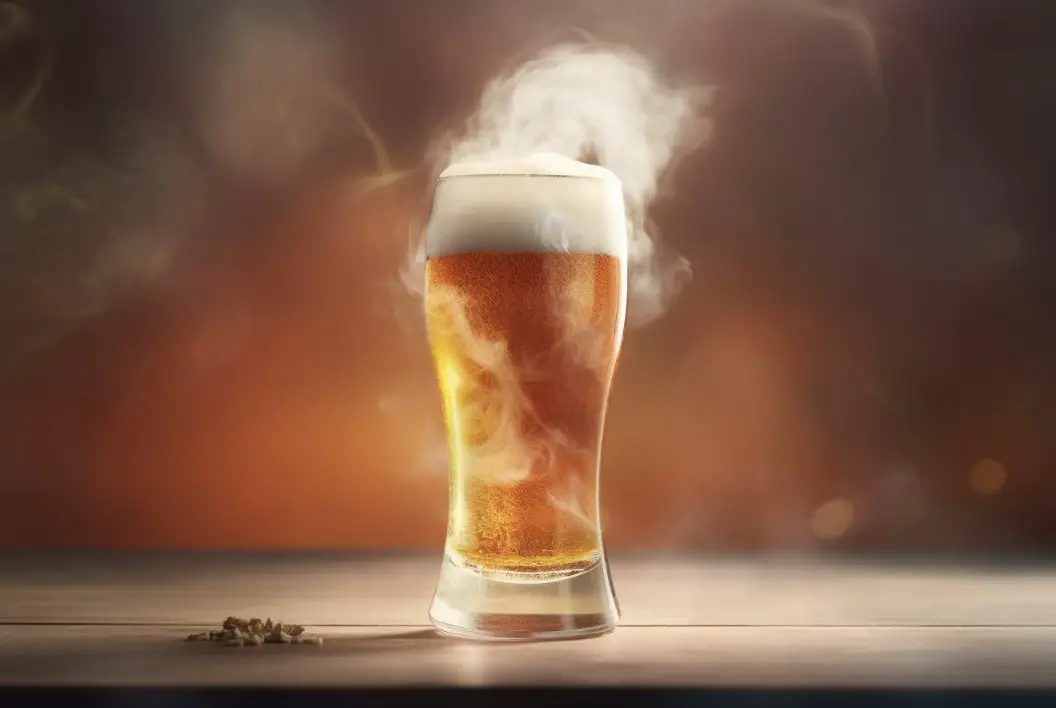As a passionate brewer and beer enthusiast, I often find myself diving into the world of brewing and exploring the differences between various beer styles.
One of the most common questions I come across is, what is the difference between a wheat ale and a pale ale? In this blog post, we will take an in-depth look at these two popular beer styles, and find out what sets them apart from each other.
The main difference between a wheat ale and a pale ale lies in the type of malt used in the brewing process.
Wheat ales are brewed with a significant amount of wheat malt, while pale ales are brewed using predominantly pale malt.
Additionally, wheat ales tend to have a hazy appearance and a fruity, spicy aroma, while pale ales are usually clear and have a hop-forward aroma and flavor.
1. The Brewing Process
The brewing process is a fascinating and intricate procedure that involves a delicate balance of art and science. Every step in the process, from selecting the right ingredients to fermentation and bottling, plays a crucial role in determining the final taste and quality of the beer. When it comes to brewing a wheat ale or a pale ale, the process can vary slightly to bring out the unique flavors and characteristics of each style.
Wheat Ales
Wheat ales are brewed using malted wheat, which typically makes up at least 50% of the grain bill. The use of wheat malt results in a lighter body and a slightly sweet, bready flavor. Wheat ales generally undergo a top-fermentation process, with ale yeast strains that contribute to the fruity and spicy characteristics of the beer.
Pale Ales
Pale ales, on the other hand, are brewed using predominantly pale malt, which imparts a lighter color and a clean, crisp malt flavor. Pale ales are also top-fermented using ale yeast strains, but the focus is usually on the hops, which provide the beer’s signature bitterness and aroma.
2. Appearance

Wheat Ales
-Hazy: Due to the high protein content in wheat malt, wheat ales often have a hazy or cloudy appearance.
-Color: Wheat ales can range in color from pale straw to deep gold, depending on the specific style and brewing techniques used.
Pale Ales
-Clear: Pale ales are generally clear, thanks to the lower protein content in pale malt and the use of fining agents during the brewing process.
-Color: The color of pale ales can vary from deep gold to amber, depending on the malt and hops used.
3. Aroma
When it comes to beer, aroma is a crucial aspect of the sensory experience. The way a beer smells can greatly influence our perception of its flavor and overall enjoyment.
This is particularly true for wheat ales and pale ales, two styles of beer known for their distinct aromas.
In this section, we’ll explore the different aromas that can be found in these beers and what makes them so unique. From fruity and floral notes to spicy and earthy undertones, we’ll take a closer look at what gives wheat ales and pale ales their signature scents.
Wheat Ales
-Fruity & Spicy: Wheat ales are known for their fruity and spicy aroma, which can include notes of banana, clove, and even bubblegum. This is due to the specific yeast strains and fermentation techniques used in brewing wheat ales.
Pale Ales
-Hop-Forward: The aroma of pale ales is typically dominated by the hops used in the brewing process. This can include a wide range of hop characteristics, such as citrus, pine, floral, and earthy notes, depending on the specific hop varieties used.
4. Flavor
When it comes to beer, flavor is everything. And two popular styles that offer distinct taste experiences are wheat ale and pale ale. Wheat ale is known for its light and refreshing taste, often with hints of citrus and spice, while pale ale offers a more bitter, hoppy flavor with notes of fruit and floral undertones.

In this section, we’ll take a closer look at the unique flavors of each style and what sets them apart from one another.
Wheat Ales
-Mild & Refreshing: Wheat ales are characterized by their mild, refreshing flavor, with a slight sweetness from the wheat malt and fruity, spicy notes from the yeast. Some wheat ales may also have a subtle tartness or acidity.
Pale Ales
-Hoppy & Bitter: Pale ales are known for their hop-forward flavor, which can range from moderately bitter to intensely bitter, depending on the specific style and brewing techniques. The malt backbone in pale ales provides balance and support for the hop flavors, resulting in a beer that is both complex and easy to drink.
5. Mouthfeel
When it comes to beer, flavor isn’t the only thing that matters. The mouthfeel, or the way a beer feels in your mouth, is just as important. Two popular beer styles, wheat ale and pale ale, offer unique mouthfeels that can enhance the overall drinking experience. Understanding the differences between these two styles can help beer enthusiasts appreciate their nuances and choose the right beer for their preferences.
Wheat Ales
-Creamy & Smooth: The high protein content in wheat malt contributes to a creamy, smooth mouthfeel in wheat ales. This is often accompanied by a moderate to high carbonation level, which adds to the overall refreshing quality of the beer.
Pale Ales
-Crisp & Clean: The mouthfeel of pale ales is typically crisp and clean, with a moderate carbonation level that helps to enhance the hop flavors and create a balanced, easy-drinking beer.
6. Alcohol Content
When it comes to beer, one of the most important factors to consider is the alcohol content. This characteristic can greatly affect the taste, aroma, and overall drinking experience. In this section, we will compare the alcohol content of two popular beer styles: wheat ale and pale ale. Understanding the alcohol content of these beers can help you make informed decisions about what to drink and when.
Wheat Ales
-Moderate: The alcohol content in wheat ales typically falls within the moderate range of 4-6% ABV (alcohol by volume).
Pale Ales
-Varied: The alcohol content in pale ales can vary widely, from sessionable pale ales with an ABV of around 3-4% to strong, imperial pale ales with an ABV of 7% or higher.
7. Popular Styles
There are some styles of pale ales and wheat ales that you cannot miss as a beer connoisseur.
Wheat Ales
-Hefeweizen: A German-style wheat ale with a hazy appearance, fruity banana and clove aroma, and a smooth, creamy mouthfeel.
-Witbier: A Belgian-style wheat ale brewed with coriander and orange peel, resulting in a fruity, spicy, and slightly tart flavor profile.
Pale Ales
-English Pale Ale: A balanced, malt-forward pale ale with moderate hop bitterness and a clean, crisp finish.
-American Pale Ale: A hop-forward pale ale with a strong hop aroma and flavor, often showcasing citrus and pine characteristics from the use of American hop varieties.
8. Food Pairings
When it comes to beer and food pairings, wheat ale and pale ale offer distinct flavors that can complement a wide range of dishes.
Wheat ale, with its light and refreshing taste, pairs well with seafood, salads, and lighter fare, while pale ale’s hoppy and bitter notes make it a great match for spicy and bold flavors, grilled meats, and burgers.
In this section, we’ll explore the best food pairings for these two popular beer styles and help you elevate your next meal.
Wheat Ales
-Seafood: The light, refreshing quality of wheat ales pairs well with delicate seafood dishes, such as grilled shrimp or ceviche.
-Salads: The fruity, spicy flavors in wheat ales complement fresh, crisp salads with ingredients like mixed greens, goat cheese, and vinaigrette.
Pale Ales
-Burgers & BBQ: The hoppy, bitter flavors in pale ales cut through the rich, savory flavors of grilled meats and barbecue dishes.
-Spicy Foods: The bold hop flavors in pale ales can stand up to spicy dishes, like Thai curry or buffalo wings, helping to cleanse the palate between bites.
9. Brewing Tips
When it comes to brewing beer, the process can be both challenging and rewarding. Whether you’re a seasoned brewer or just starting out, there are certain tips and techniques that can help you create the perfect batch.
In this section, we’ll explore some brewing tips specifically for wheat ales and pale ales. These two popular styles have distinct characteristics and require slightly different approaches in the brewing process.
By following these tips, you’ll be well on your way to brewing delicious, refreshing beers that are sure to impress.
Wheat Ales
-Protein Rest: A protein rest during the mashing process can help to break down the high protein content in wheat malt, improving the clarity and mouthfeel of the finished beer.
-Fermentation Temperature: Fermenting at a slightly higher temperature can enhance the fruity, spicy esters produced by the yeast, adding complexity to the beer’s aroma and flavor.
Pale Ales
-Hop Additions: Adding hops at various stages during the boiling process can help to create a complex hop profile, with a balance of bitterness, flavor, and aroma.
-Dry Hopping: Adding hops during the fermentation or conditioning stage can help to boost the hop aroma in pale ales, creating a more pronounced and vibrant hop character.
Conclusion
In conclusion, the main difference between a wheat ale and a pale ale is the type of malt used in the brewing process, which impacts the appearance, aroma, flavor, and mouthfeel of the beer.
Wheat ales are brewed with a significant amount of wheat malt, while pale ales are brewed using predominantly pale malt.
Additionally, wheat ales tend to have a hazy appearance and a fruity, spicy aroma, while pale ales are usually clear and have a hop-forward aroma and flavor.
Here are 10 quick facts about wheat ales and pale ales to take away:
1. Wheat ales use at least 50% wheat malt in their grain bill.
2. Pale ales predominantly use pale malt.
3. Wheat ales have a hazy appearance due to the high protein content in wheat malt.
4. Pale ales are usually clear.
5. Wheat ales have a fruity and spicy aroma, while pale ales have a hop-forward aroma.
6. Wheat ales have a mild, refreshing flavor, while pale ales have a hoppy, bitter flavor.
7. Wheat ales have a creamy, smooth mouthfeel, while pale ales have a crisp, clean mouthfeel.
8. Wheat ales typically have a moderate alcohol content, while pale ales can vary widely.
9. Popular styles of wheat ales include Hefeweizen and Witbier, while popular styles of pale ales include English Pale Ale and American Pale Ale.
10. Wheat ales pair well with seafood and salads, while pale ales pair well with burgers, BBQ, and spicy foods.
FAQs
What is the difference between wheat ale and beer?
Wheat ale is a type of beer that is brewed with a significant amount of wheat in addition to barley, while beer can be made with a variety of grains including barley, wheat, rye, and corn. Wheat ales tend to have a lighter body and a crisp, refreshing taste, while other types of beer can vary in flavor and texture depending on the grain used and the brewing process.
What is a wheat pale ale?
A wheat pale ale is a beer style that combines the use of wheat malt with pale ale malt to create a light-bodied, refreshing beer with a crisp, hoppy flavor. It often has a hazy appearance due to the presence of wheat proteins and is typically lower in alcohol content than traditional pale ales.
Is wheat beer different from regular beer?
Yes, wheat beer is different from regular beer. It is made with a higher percentage of wheat malt instead of barley malt, which gives it a lighter color, cloudier appearance, and a unique flavor profile that is often described as fruity, spicy, and refreshing. Additionally, wheat beer is often brewed with a specific type of yeast that produces distinct aromas and flavors, such as banana and clove.
How is wheat ale made?
Wheat ale is typically made with a mixture of malted barley and wheat, with the wheat providing a lighter body and crisp finish. The grains are mashed together with hot water to extract the sugars, boiled with hops for bitterness and flavor, then fermented with yeast to produce alcohol and carbonation. Some wheat ales may also be flavored with spices or fruits for added complexity.
Is a pale ale a wheat ale?
No, a pale ale is not a wheat ale. A pale ale is typically made with pale malted barley, while a wheat ale is made with wheat malt.
What is the difference between beer and pale ale?
Pale ale is a type of beer that is characterized by its pale color, high hop content, and fruity or floral notes. Beer, on the other hand, is a broad category that includes many different styles, including pale ale. Therefore, the main difference between beer and pale ale is that pale ale is a specific type of beer with distinct characteristics, while beer is a more general term that encompasses many different styles and flavors.
What makes a beer a wheat ale?
A wheat ale is a beer that is brewed with a significant portion of wheat in addition to barley malt. This results in a lighter-bodied beer with a crisp, refreshing taste and a slightly hazy appearance. Wheat ales often have a slightly sweet and fruity flavor profile and are commonly served with a slice of citrus fruit to enhance their brightness.



